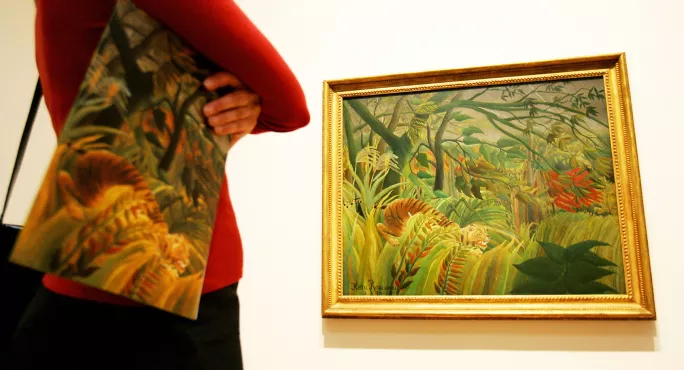- Home
- Teaching & Learning
- Primary
- How to have a pupil-led art lesson that actually works
How to have a pupil-led art lesson that actually works

Art is one of the great loves of my life and I see how it enriches the curriculum, our pupils and us as teachers.
At our school we’ve placed art at the heart of our curriculum. It feeds into every other subject area, whether that’s discovering science using mixed mediums, taking a journey through history using art or learning new words by describing artworks. Most of these classes are pupil-led and it has been through this pedagogical approach that I’ve seen the children flourish.
Art has helped our youngest to find their voices and value their own perspectives and opinions. I’ve also seen it foster a sense of community and empathy, with children finding shared interests and appreciating different perspectives.
But I know too well that art in schools can often be overlooked. It can feel too much like child’s play or, at the other end of the spectrum, can seem stuffy or intimidating.
- Experts warn of an “arts apocalypse” in schools
- Why it’s time to ditch the pointless art projects in EYFS
- Undervaluing arts subjects “naive”, warns heads’ union
I’m determined to change that and help staff to deliver foolproof and engaging pupil-led art classes. You can use any art to get started, although I really enjoy using The Superpower of Looking’s resources, which provide my pupils with an initial learning framework.
These are also particularly valuable for those teachers who aren’t art specialists because they provide the tools, guidance and confidence to deliver exciting and engaging lessons in a way that resonates with children, getting them to use their “superpower” of looking. This builds visual literacy, which helps pupils to critically observe, analyse, question, interpret and communicate with confidence.
Here’s how I go about it:
Delivering pupil-led art lessons in primary
Focus the lesson
I start lessons by asking the pupils to choose the artwork they are most interested in. I usually create a shortlist and put this to a vote, but it’s helpful to start the lesson as you mean to go on - by asking pupils to stop, think and then communicate. Getting pupils to select the artwork for the lesson establishes and helps to maintain engagement throughout the class. One of my favourites is Surprised! by Henri Rousseau (see main picture).
Explore the artwork
Once the artwork is chosen, we use various media to explore the piece. Again, pupils are invited to choose their own pathway. In my classroom, this is usually through printed copies for the pupils to hold, on an iPad so they can zoom in and out or in the video resource so they can learn alongside the commentary. I find this choice important because it helps to support different learning preferences and creates more excitement in the classroom.
We then usually discuss the painting and I empower the pupils to lead this by sharing their observations and asking questions of each other. Some questions to get things underway could include: “What do you see?”, “What do you like about the painting?”, “How does this painting make you feel?”
As a teacher, this is a rewarding part of the lesson because you start to see pupils developing critical visual literacy skills, which help them to observe, question, interpret and communicate with confidence.
Bring the lesson to life
Next is the hands-on part of the lesson, again led by the pupils. I always ask my class what they want to do next, and it leads to a wonderful mix of responses.
Some pupils may recreate the artwork by copying it with paints or pencils. Others may want to zoom in on different areas of the painting.
Using Surprised! as an example, I’ve had pupils recreate the grass by using leaves from the playground, while others have enjoyed thinking more about the tiger and creating their own artwork to depict what he’s looking at. This approach allows pupils to work at their own pace and ability while fostering a love and enjoyment of learning.
Show and tell
So much of what we’re developing through art is pupils’ critical thinking, visual literacy and ability to consider and appreciate different perspectives. Asking everyone to share and describe their creation is an important part of this. I’ve also found that as pupils present, classmates will ask questions and identify hidden aspects of each artwork, which prompts further class discussion and learning, and, importantly, engagement to the very end.
I truly believe that curriculum development should be a two-way process, inviting collaboration between pupils and teachers. By adopting a pupil-led approach to art, my hope is that you will find the subject more accessible and enriching, and inject a new sense of purpose into the classroom.
Mandy Barrett is specialist art teacher at Gomersal Primary School in West Yorkshire
For the latest research, pedagogy and practical classroom advice delivered directly to your inbox every week, sign up to our Teaching Essentials newsletter
You need a Tes subscription to read this article
Subscribe now to read this article and get other subscriber-only content:
- Unlimited access to all Tes magazine content
- Exclusive subscriber-only stories
- Award-winning email newsletters
Already a subscriber? Log in
You need a subscription to read this article
Subscribe now to read this article and get other subscriber-only content, including:
- Unlimited access to all Tes magazine content
- Exclusive subscriber-only stories
- Award-winning email newsletters
topics in this article



